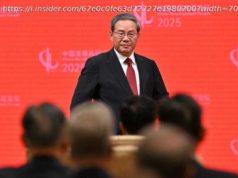China’s yuan climbed at its fastest pace against the greenback in a year in offshore trade Thursday, offering some relief to a currency bedeviled by capital outflow concerns recently.
On Thursday, dollar was fetching as little as 6.8071 yuan in intraday, offshore trade, the pair’s lowest since November. On Wednesday, the dollar/yuan pair had its largest drop in a year in the offshore market, falling from as high as 6.9688 to as low as 6.8658.
In part, that reflected the yuan’s climb onshore , as well as move by the People’s Bank of China (PBOC) to set its yuan mid-point at 6.9307 against the dollar, down from 6.9526 on Wednesday.
China’s central bank does not allow the currency to move more than 2 percent from its daily fixing in onshore trade. While policymakers cannot closely control offshore trade of the currency, it usually remains relatively close to its onshore counterpart.
On Thursday, the difference between the onshore and offshore trade was stark. Onshore, the dollar was fetching 6.8952 yuan.
But analysts noted that the offshore yuan’s move was also driven by mainland policymakers’ apparent efforts to tighten capital controls.
China regulators introduced new rules, which will take effect in July, requiring financial institutions on the mainland to report domestic and overseas cash transactions of more than 50,000 yuan (around $7,217), down from 200,000 yuan previously, Reuters reported.
Starting from January 1, the country’s foreign-exchange regulator also planned to step up scrutiny on foreign-currency purchases, Reuters reported.
Additionally, overnight Hibor, or the Hong Kong interbank offered rate, for the offshore yuan, was pushed higher, reaching as high as 17.76 percent on Tuesday, before slipping to around 16.95 percent on Wednesday. On Thursday, Reuters reported the rate was set at 38.335 percent.
Mirza Baig, head of foreign exchange and interest rate strategy for Asia at BNP Paribas, said that level, similar to what would be seen in economically troubled Brazil, served up a punitive interest rate on any short renminbi position in the offshore-yuan market.
“That high cost of funding combined with more measures to restrict capital outflows” buoyed the yuan, noted Baig.
Economists at Citi also pointed to short-covering in the offshore yuan.
“We have often pointed out that tight offshore-yuan funding is a low-cost option for authorities to shake out speculative offshore-yuan shorts — because it poses a negligible risk to the mainland economy — and can thus be persisted with for longer than investors anticipate,” Citi said in a note dated late Wednesday U. S. time.
It noted that shorting the offshore yuan — or taking a long dollar/offshore yuan position — had become “rather expensive. ”
The analysts cited several reasons for the sudden resilience of the offshore yuan.
“The widely-held view that pressure on the renminbi would intensify at the start of the year is being rapidly reassessed amidst persistently high funding costs in the offshore yuan, reports suggesting U. S. dollar sales by state-owned enterprises, stricter monitoring of capital outflows, and an apparent change in methodology for setting the daily dollar/yuan midpoint,” Citi said.
In a previous note, Citi has said that policymakers appeared to be setting the midpoint for a slightly stronger yuan than would be suggested by the currency’s trade-weighted basket.
The mainland’s currency has recently become a source of political tension with the U. S., with President-elect Trump vowing during his campaign to label the country a currency manipulator for the purposes of a competitive trade advantage and threatening to impose a 45 percent tariff on its exports to the U. S.
In the wake of the Trump win, the yuan fell to nearly eight year lows against the dollar, touching its weakest since at least January 2009, during the global financial crisis. But analysts attributed the slide primarily to the strength of the dollar, with the dollar index , which measures the greenback against a basket of currencies, surging to a 14-year high after the election.
Some analysts had noted that, based on currency movements within the yuan’s trade-weighted basket, policymakers appeared to be supporting the yuan somewhat.
Analysts generally don’t expect the yuan will continue to climb much against the dollar, even as the country faced the likelihood that capital outflows would remain relatively high.
Geoff Lewis, global market strategist at Manulife Asset Management, told CNBC’s “Squawk Box” on Thursday that he expected the yuan to fall around 4-5 percent against the dollar this year, a slower pace of depreciation than 2016’s around 7 percent.
“I think what we’re talking about here is a renminbi which weakens in line with other currencies. There’s no harm in that. I don’t think Beijing will try and resist that,” Lewis said.
“The capital account is relatively poor,” he said, but he added, “China still has enough reserves to prevent the renminbi from crashing. ”
He noted that while there were concerns that the mainland’s foreign-exchange reserves might fall below the psychological $3 trillion mark, he didn’t attach much real significance to psychological levels as $3 trillion was still a sizable pot.
In November, China’s foreign reserves fell to $3.052 trillion, a nearly six-year low, Reuters reported. December’s data were due on Saturday.
Lewis wasn’t alone in shrugging off the upcoming data.
“I think it is not of huge significance to the market, because it does not convey the full picture of Chinese authorities’ intervention in the foreign-exchange market,” BNP Paribas’ Baig said.

 China’s yuan climbed at its fastest pace against the greenback in a year in offshore trade Thursday, offering some relief to a currency bedeviled by capital outflow concerns recently.
China’s yuan climbed at its fastest pace against the greenback in a year in offshore trade Thursday, offering some relief to a currency bedeviled by capital outflow concerns recently. 




